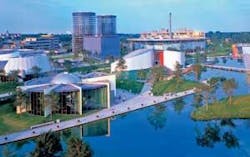Eyeballin’ da rides
So here I am standing on a train station platform in Wolfsburg, Germany, waiting for the next train to Frankfurt. It’s a beautiful fall morning. Across the barge canal adjacent to the tracks is the historic Volkswagen Werks, easily identifiable by the four chimneys of the power plant that survived World War II. In front of me are the buildings of the Wolfsburg works where laser welded Golf V and Passat vehicles are assembled.
In the photo to the left is the ultra-modern Auto Stadt, a sort of automotive Epcot center where several pavilions are dedicated to the various VW brands; Audi, Bentley, Lamborghini, SEAT, Skoda, and of course VW.
Dominating the designer challenged pavilions are the twin towers of Auto Türme (shown at left in the photo), the VW auto delivery system-20 stories of circular conveyors down which proceed vehicles being finalized for delivery to patiently waiting German buyers in the adjacent Kunden Center. In the center are monitors that display the name of the car buyers, their dealers, and at what precise moment their car will drive down a ramp to be turned over to the unfailingly smiling customer, typically a family, who have been enjoying a day at the Auto Stadt with its various attractions, including many that are child friendly.
I’m here at the invitation of Klaus Loeffler, director of joining for Volkswagen, who has arranged an annual conference and vendor exhibit focused on the latest laser developments in auto manufacturing. Contrary to European tradition this conference lacks an acronym, a situation Klaus says he plans to modify.
Yesterday at the close of the conference I was visiting the Kunden Center with Frank DiPietro (L.A.S.E. Inc.) and Koichi Isihara (Hybrid Technology Systems Co. Ltd.). On the showroom floor were the latest models of each of the VW cars from the low-cost new Beetle to the top-of-the-line Phaeton. With a critical eye, sharpened by what we had learned at the conference, we were examining each vehicle for laser processed components, from the 17 meters of welds and braze joints on the Passat to the hybrid welded side panels of the Phaeton.
I was amused by the look on the faces of prospective buyers sitting in the cars as the three of us traced roof seams for braze joints, looked under the trunk lid for remotely welded seams, and along the sills for tailored blank welds. Most amusing was seeing Frank crawl under a car looking for laser welded cross members and evidence of welded blanks. Thankfully the showroom floor was clean enough to eat from so his suit showed no stains.
The conference, a sellout, with more than three dozen people on the wait list, presents the latest technology in laser processing of body-in-white and components. Speakers from the auto companies, their laser and systems suppliers, and the R&D community presented an overview of new technologies such as remote welding, combination cutting/welding heads, and laser brazing. For the first time a U.S. Tier 1 supplier, Dana Corporation, shared with Europeans its experiences with laser welding the aluminum frame of the Corvette Z06.
As an aside this presenter, Richard Marando, told us that the company operates three types of lasers in this plant, lamp- and diode-pumped Nd:YAG and a new fiber laser, under the same conditions on the same body parts. He has offered to share this laser experience at next year’s ALAW meeting.
It’s fun to travel with Frank, whose face still lights up when he sees advances being made in his favorite technology. When an old die stamping guy like him comments on the laser’s opportunity in welding new boron-based steels you get a measured perspective on where this technology will be in the coming years. It looks good to me!
David A. Belforte
[email protected]


